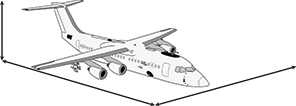Aircraft: ECO Dimona - UEDIN
Dimensions
- Length: 7.28 m
- Height: 1.8 m
- Wingspan: 16.33 m
 7.28 m
1.8 m
16.33 m
7.28 m
1.8 m
16.33 m
Flying performances
Speed| Min speed | 24 m/s |
| Max speed | 73 m/s |
| Usual speed during measurements | 41 m/s |
| Usual speed during transit flights | 46 m/s |
| Ascent rate | 3 m/s |
| Min altitude |
|
| Max ceiling | 16 400 ft |
| Usual ceiling during measurements | 10 000 ft |
| Ceiling limitations | oxygen above FL100 |
| Empty weight | 640 kg |
| Max take-off weight | 930 kg |
| Max payload | 143 kg |
| Max scientific payload | 143 kg (X-coordinate of 2nd point) |
| Usual scientific payload during measurements | 110 kg |
| Scientific payload for max endurance | n/c |
Endurance
| Max endurance at min scientific payload and max fuel | 5 h (Y-coordinate of 1st point) |
| Endurance at max scientific payload | 3 h (Y-coordinate of 2nd point) |
Range
| Max range | 833 km (at min scientific payload and max fuel) |
| Conditions for max range |
high cruise altitude |
| Range at max scientific payload | None km |
| Usual range during measurement flight | 626 km |
Other
| Weather conditions limitations |
VFR, daytime, crosswind: 8 kts |
| Take-off runway length | 337 m |
| Engines | 1 x Rotax 914 F3 |
| Avionics | n/c |
Crew and scientists on board
| Crew (pilots + operators) |
1 |
| Seats available for scientists | 1 |
Cabin
| Length | n/a m |
| Width | n/a m |
| Height | n/a m |
| Apertures | n/a |
| Cabin pressurized | no |
| More information | Two seats side by side. Small "baggage" area for payload behind seats, max 30 kg |
Aircraft modifications
| Nose boom | no |
| Windows | adapter plate for small inlets |
| Openings | Port side underwing pod fitted with view ports for optical sensors; these are open ports. |
| Hard points | Each wing is equipped with an underwing pod, max 55 kg total mass each side. |
| Inlets | On each underwing pod; available via storm window and baggae area port. |
| Additionnal systems | no |
Acquisition systems
Data is generally logged locally within each functional system as well as key outputs being redundantly logged centrally (2 x CSI CR1000 dataloggers) and, in some cases, on other systems where such data may be relevant. All systems are networked and real time monitoring /control as well as data retrieval are performed remotely via a central 'Control/Display Computer' (the exceptions being hyperspectal and photograhic imaging, where swappable SSD / memory cards are used for data transfer). Data may also be retrieved across the network directly to an external ruggedised PC with local RAID storage and hot-swappable drives via umbilical. The network also provides system synchronisation via GPS-based NTP signal (which is also broadcast in NMEA/PPS for precsion synchronisation where available).
Electrical power
| Aircraft total electrical power (kW) | 2 kW |
| Electrical power (kW) and voltages (V) available for scientists | 0.8 kW; Each payload bay (i.e. each pod and the cabin) is provided with 6 independently switched circuits as follows: 2 x 28 VDC; 2 x 14 VDC; 1 x 5 VDC; 1 x 115 VAC single phase 60 Hz. |
